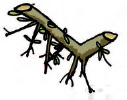3.1: Nature's Medicine Cabinet
- Page ID
- 211473
Times have changed, but more than half of the world's population still relies entirely on plants for medicines, and plants supply the active ingredients of most traditional medical products. Plants have also served as the starting point for countless drugs on the market today. Researchers generally agree that natural products from plants and other organisms have been the most consistently successful source for ideas for new drugs, since nature is a master chemist. Drug discovery scientists often refer to these ideas as "leads," and chemicals that have desirable properties in lab tests are called lead compounds.
Natural Cholesterol-Buster

Having high cholesterol is a significant risk factor for heart disease, a leading cause of death in the industrialized world. Pharmacology research has made major strides in helping people deal with this problem. Scientists Michael Brown and Joseph Goldstein, both of the University of Texas Southwestern Medical Center at Dallas, won the 1985 Nobel Prize in physiology or medicine for their fundamental work determining how the body metabolizes cholesterol. This research, part of which first identified cholesterol receptors, led to the development of the popular cholesterol-lowering "statin" drugs such as Mevacor® and Lipitor®.
New research from pharmacologist David Mangelsdorf, also at the University of Texas Southwestern Medical Center at Dallas, is pointing to another potential treatment for high cholesterol. The "new" substance has the tongue-twisting name guggulsterone, and it isn't really new at all. Guggulsterone comes from the sap of the guggul tree, a species native to India, and has been used in India's Ayurvedic medicine since at least 600 B.C, to treat a wide variety of ailments, including obesity and cholesterol disorders. Mangelsdorf and his coworker David Moore of Baylor College of Medicine in Houston, Texas, found that guggulsterone blocks a protein called the FXR receptor that plays a role in cholesterol metabolism, converting cholesterol in the blood to bile acids. According to Mangelsdorf, since elevated levels of bile acids can actually boost cholesterol, blocking FXR helps to bring cholesterol counts down.

Sap from the guggul tree, a species native to India, contains a substance that may help fight heart disease.
Relatively speaking, very few species of living things on Earth have actually been seen and named by scientists. Many of these unidentified organisms aren't necessarily lurking in uninhabited places. A few years ago, for instance, scientists identified a brand-new species of millipede in a rotting leaf pile in New York City's Central Park, an area visited by thousands of people every day.
Scientists estimate that Earth is home to at least 250,000 different species of plants, and that up to 30 million species of insects crawl or fly somewhere around the globe. Equal numbers of species of fungi, algae, and bacteria probably also exist. Despite these vast numbers, chemists have tested only a few of these organisms to see whether they harbor some sort of medically useful substance.
Pharmaceutical chemists seek ideas for new drugs not only in plants, but in any part of nature where they may find valuable clues. This includes searching for organisms from what has been called the last unexplored frontier: the seawater that blankets nearly three-quarters of Earth.
Cancer Therapy Sees the Light
A novel drug delivery system called photodynamic therapy combines an ancient plant remedy, modern blood transfusion techniques, and light. Photodynamic therapy has been approved by the Food and Drug Administration to treat several cancers and certain types of age-related macular degeneration, a devastating eye disease that is the leading cause of blindness in North America and Europe. Photodynamic therapy is also being tested as a treatment for some skin and immune disorders.
The key ingredient in this therapy is psoralen, a plant-derived chemical that has a peculiar property: It is inactive until exposed to light. Psoralen is the active ingredient in a Nile-dwelling weed called ammi. This remedy was used by ancient Egyptians, who noticed that people became prone to sunburn after eating the weed. Modern researchers explained this phenomenon by discovering that psoralen, after being digested, goes to the skin's surface, where it is activated by the sun's ultraviolet rays. Activated psoralen attaches tenaciously to the DNA of rapidly dividing cancer cells and kills them. Photopheresis, a method that exposes a psoralen-like drug to certain wave lengths of light, is approved for the treatment of some forms of lymphoma, a cancer of white blood cells.

Some forms of cancer can be treated with photodynamic therapy, in which a cancer-killing molecule is activated by certain wavelengths of light.
JOSEPH FRIEDBERG

